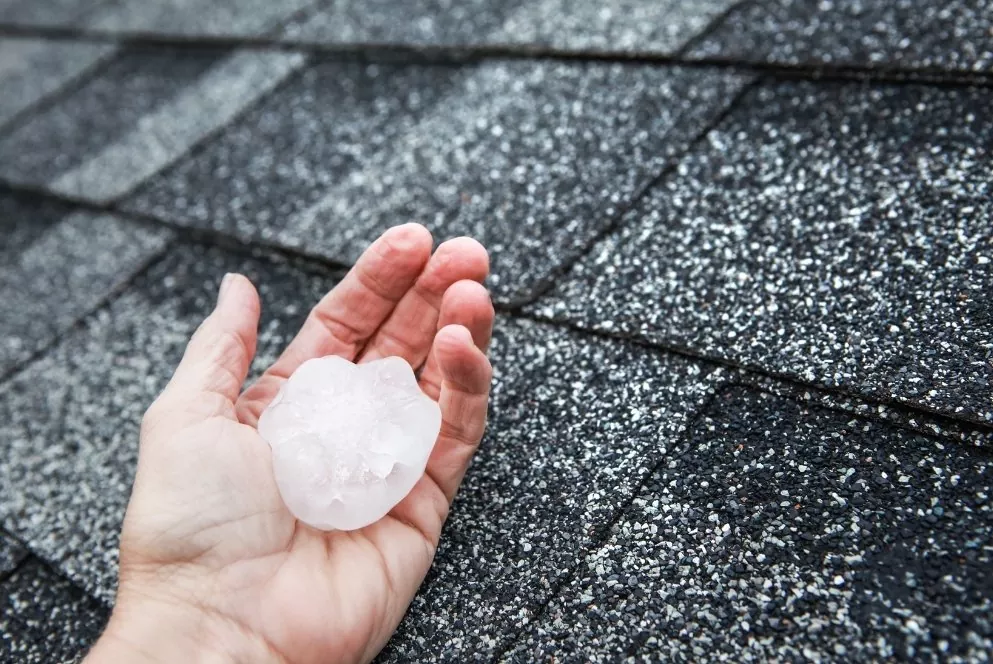Your roof should be able to withstand different weather conditions, but severe storms could cause damage. Minnesota gets its share of bad weather each year, from ice dams and hail storms to tornadoes and torrential downpours. When severe weather hits your local area, it’s essential to know if your roof is damaged. Keep the following signs of storm damage in mind, so you can have professional roofing repairs done right away.
Need a Storm Damage Inspection?
Missing or Damaged Shingles Indicate Storm Damage
High winds and debris can damage your roof shingles or tear them off entirely. When you look up at your roof after severe weather, check for missing shingles or shingles with cracks or other visible damage. You might also see loose shingles that haven’t fallen off yet. Having shingles missing from your roof leaves openings that let water get into your home, which can cause severe and costly damage. Shingles that are damaged in storms might also have cracks or gaps that allow moisture in. It’s important to have missing or damaged roof shingles replaced as soon as possible to keep your home protected from wind and water.
Roof Leaks Can Be a Sign Of Storm Damage
Heavy rain or frequent rainstorms can lead to roof leaks, especially if your roof has any openings or gaps. For example, cracked or damaged flashing around vents or chimneys can allow rainwater to leak inside your home. When it storms, you should check your attic, as well as walls and ceilings in other areas, for signs of leaks. You might have a roof leak if you see water stains or spots in your attic or on walls and ceilings. If you smell or see mold or mildew, this can also mean that you have a roof leak. Other signs of roof leaks include areas of damp wood inside your attic or walls.
Storm Damage and Clogged or Leaky Gutters
Your gutters usually let rainwater move away from the exterior of your home, which helps prevent water damage. Debris or storm damage to your gutters and downspouts can block water from flowing through. Instead, rainwater can build up in your gutters and overflow or leak. When clogged or leaky gutters aren’t repaired, water can back up and seep under your roof shingles. This can cause severe water damage to your home interior. You might also have areas of standing water on your property that can damage your yard when you have gutter clogs or leaks. You should look for signs of damage to your gutters after storms, such as loose gutters or gutters that are dented.
Storm Damage To Roofing Can Cause Loose Shingle Granules
The shingles on your roof have granules that protect against damage from the sun’s UV rays. Severe weather, such as hail, downpours, or heavy winds, can knock these granules off your shingles, which leaves them more vulnerable to damage from UV exposure. While it’s normal to see small granule piles near downspouts every so often due to wear and tear, seeing larger amounts after storms could indicate storm damage. Another sign of granule loss is seeing areas on your shingles that look bare. If you notice larger areas that look bare, you should have your roof checked for storm damage.
Dents in Your Roof and Storm Damage
Storms can end up affecting the appearance of your roof and putting your home at risk of water damage. Severe hail storms can cover your roof with a large number of dents. Wind storms can blow tree branches and other debris around, which can also scratch and dent your roof. Dents can give your roof an unsightly look and damage shingles. This damage can make it easier for moisture or water to seep through your roof and get into your attic, leading to water damage inside your home. You might be able to see dents on your roof after a hail or wind storm when you’re looking up from the ground. However, you should have a professional inspection done to assess this kind of damage.
What to Do About Storm Damage
If you think your roof might be damaged due to storms, you should have professional roofing contractors do an inspection. Roofing experts can get up onto your roof safely and check for signs of storm damage. If your roof is damaged, these professionals can determine how bad and what kinds of repairs are needed. You can then have your roofing contractors handle these repairs to get your roof back to being in good condition. Keep in mind that having storm damage restoration or repairs done promptly reduces the risk of having this kind of damage get worse. In severe cases, storm damage can make your roof unsafe and put your home at risk of significant water damage.
If your roof ends up with storm damage after severe weather, contact Elysian Construction as soon as possible. Our professional contractors provide repair and restoration services for damage caused by hail, ice, snow, wind, and other weather.
